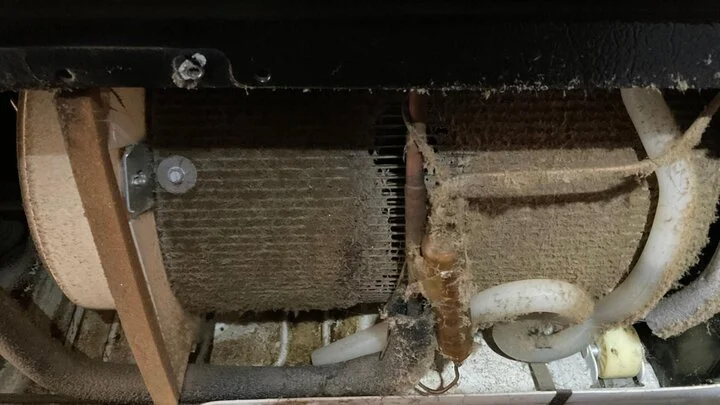To keep your refrigerator running efficiently and prolong its lifespan, regular maintenance and cleaning are crucial. One of the components that often gets overlooked but requires special attention is the condenser coil (or evaporator coil) at the back of the appliance.
Your Refrigerator Has a Special Component That Needs Cleaning Twice a Year
The condenser coil, also known as the condensing unit, is an essential part of your refrigerator’s cooling system and plays a pivotal role in its cooling performance and energy consumption. Its function is to dissipate heat from the refrigerant, aiding in cooling the interior of the fridge. Typically located at the back or bottom of the refrigerator, the condenser coil consists of metal cooling fins and tubing.
When the condenser coil is covered in dust and debris, it cannot efficiently release heat to the outside environment. As a result, the compressor has to work harder to maintain the desired temperature inside the fridge, leading to decreased cooling efficiency and increased energy consumption. Cleaning the condenser coil is the key to enhancing your refrigerator’s performance and reducing its power usage.

Condenser Coil – The Special Component at the Back of Your Fridge That Needs Cleaning Twice a Year. (Photo: Alumni)
A dirty condenser coil causes the compressor to work continuously and overload, leading to premature wear and tear and potential breakdowns. Regular cleaning of the coil reduces the strain on the compressor, thus extending the lifespan of your refrigerator.
Moreover, dust and debris buildup on the coil can pose a fire hazard, especially if the fridge is placed near heat sources. Cleaning the condenser coil mitigates this risk, ensuring the safety of your household.
How to Clean Your Refrigerator’s Condenser Coil
Here are the basic steps to effectively clean your refrigerator’s condenser coil:
– Disconnect the power: Prior to cleaning, ensure that you unplug the refrigerator from the power source for safety.
– Move the refrigerator: Pull the appliance away from the wall to access the condenser coil at the back or bottom. Exercise caution when moving the fridge to avoid damaging the floor and the appliance itself.
– Clean the coil: Use a soft brush or a vacuum cleaner to remove dust, dirt, and debris from the coil. Pay attention to the cooling fins and tubing, ensuring they are free of any buildup. After removing the larger particles, you can use a damp cloth to wipe down the surfaces of the coil. Make sure no dust or debris is left on the fins and tubing.
– Inspect and reposition: Once the cleaning is done, inspect the coil to ensure it is free of any remaining dust or debris. Afterward, move the refrigerator back to its original position and plug it into the power source.
Important Considerations When Cleaning Your Refrigerator’s Condenser Coil
It is recommended to clean the condenser coil at least twice a year. However, if your refrigerator is placed in a dusty environment or you have pets, more frequent cleaning may be necessary.
Use appropriate cleaning tools such as soft brushes, vacuum cleaners, and damp cloths to avoid damaging the coil. Avoid using harsh chemicals or abrasive tools that can scratch or damage the coil.
Always disconnect the power before cleaning to eliminate the risk of electrical shock. Ensure that the refrigerator is properly repositioned and safely plugged in after cleaning.
Refrigerator maintenance is not a complicated task, but it requires attention and care from the user. Take the time to maintain your appliance, especially the condenser coil, to ensure optimal performance and food preservation. By cleaning this special component at the back of your fridge twice a year, you can rest assured that your refrigerator will operate at its best, efficiently safeguarding your food.
According to VTC News
What to Check First When You Enter a Hotel Room?
As a discerning traveler, you know that a hotel room’s cleanliness can make or break your stay. So, where should you begin your inspection? The bed, of course! A quick once-over of the sheets and mattress can reveal a lot about the hygiene standards of the establishment.
A bed is the heart of a hotel room, and a clean, comfortable one is essential for a good night’s rest. So, before you unpack your bags, take a moment to inspect the bedding. Are the sheets crisp and fresh, or do they appear worn and tired? Is the mattress firm and inviting, or does it sag in the middle? These are tell-tale signs that will give you an instant impression of the room’s overall cleanliness.
A quick inspection of the bed can save you from a world of discomfort and give you peace of mind, ensuring your stay is off to a great start.






































